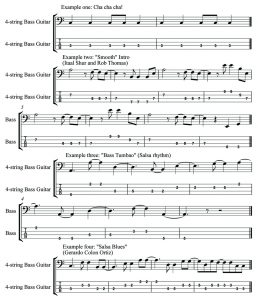Deep Thinking: Ay Caramba! Some Latin Grooves
Deep Thinking: Ay Caramba! Some Latin Grooves
Latin Grooves: In this issue we are going to look at some Afro–Cuban bass lines two of which are contemporary, and one, while from a relatively recent song, is based on a traditional Cuban rhythm.
In 1969, Santana released a song called Evil Ways (composed by Clarence Henry), which became the band’s first hit. While it is a ‘rock’ song of the period, it uses a very traditional Cuban rhythm called a ‘cha, cha, cha’.
Santana became famous as a rock band using Latin rhythms already familiar to a large section of American society, and Carlos Santana is still out there today. A resurgence of success happened with the band’s 1999 album, ‘Supernatural’ on which there is a single called Smooth that uses almost the same rhythm, though not as rigidly as the 1969 hit.
A cha, cha, cha rhythm is counted as 1, 2, ‘3 and’ 4, although the bass wouldn’t actually play this (see Example 1). The Smooth bass line (the first eight bars are in Example 2) sits somewhere between this feel and the more contemporary Cuban salsa that is present not only in Afro–Cuban dance music, but also in a lot of rock, pop, and jazz music that draws on Latin influences. The line uses an A minor oriented scale that is mostly Aeolian, although the F falling onto the E highlights the Latin sound and suggests a Phrygian scale (which always sounds Spanish).
Example 3 is what is called a ‘tumbao’ bass line, which is often used in salsa music. These lines are more difficult because they feel as if the bass is crossing the beat being laid down by the drummer. (If you watch the live version of Smooth on YouTube, the band goes into a ‘montuno’ section used for solos, most often by a pianist playing octaves in both hands, at the end of the song. This section features bassist Benny Rietveld playing a ‘tumbao’ line on electric upright.)
The art of playing this type of line over complex chord changes takes some work, but a lot of listening to the style will get you there.
Example 3 is played under a simple chord sequence (Am, D, Bm, E, G, Am, D, F, A). An easy way to play it is to break each note down to its number of quavers while listening to a 4/4 pulse from your computer or drum machine. Start slowly and build up the tempo.
Example 4 is another salsa line and it can be slapped once you get used to it, as it is slightly simpler than Example 3 (although it would be best to get the feel right first).
As noted above, this style is unlike just about every style you may have played and often has the bass crossing the groove laid down by the other members of the band. The cowbell player playing a solid 4 to the bar or a 2:3 or 3:2 clavé will be your best friend! (I’ll explain clavé rhythms in a later issue.)
Also, you may initially find that you have to almost cut yourself off from listening to soloists because the tumbao feel follows the chord sequence they are using, but your bass notes don’t always change the chords being used where other band members’ parts do. Have fun!
(Dr. Rob Burns is an Associate Professor in Music at the University of Otago. As a former professional studio bassist in the UK, he performed and recorded with David Gilmour, Pete Townsend, Jerry Donahue, Isaac Hayes, Sam and Dave, James Burton, Ian Paice and Jon Lord, Eric Burdon and members of Abba. Rob is currently a member of Dunedin bands Subject2change and The Verlaines.)


